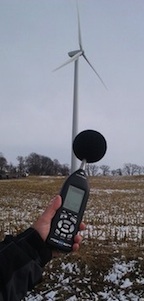Wisconsin town officials reassured by visit to wind farm
Human impacts, News, Wind turbines Add comments
Town officials from Mount Pleasant, Wisconsin recently visited a wind farm in Brownsville in order to listen and take sound measurements of turbines similar to three being proposed by a local plant that aims to generate all its energy needs on site.
What they heard reassured them, after hearing noise concerns from some local residents. “At 800 feet, measurements came in at 46 – 47 decibels, and at 1,200 feet it was less than 40 decibels, ” said Planning Director Ron Meyer. By comparison, he said a passing car on the paved road came in at 62 decibels. Even within a thousand feet, they could sometimes not hear the turbines spinning.
Of course, any quick visit to a wind farm offers just a snapshot view (or listen). In many cases, neighbors’ noise issues occur mainly in particular atmospheric or wind conditions, so the question becomes how common these above average noise events are. Stable sound-reflecting air layers above the turbines, high levels of turbulence in the air hitting the blades, and wind speed differences from the bottom to top of the blades are all factors that tend to contribute to higher or more intrusive noise levels. And, night time noise tends to be a bigger issue than day time; even moderate noise levels can become the loudest sound heard out a bedroom window at night.
Still, it’s good to get out there and get a sense of what may be heard near the proposed turbines. Unfortunately, no residents were able to join the town officials on this trip, though they were invited. It’s hard to know what degree of investigation will really give a complete picture of what may be experienced by people near the plant; spending a few nights in Brownsville might help. More generally, many towns considering wind project siting questions would be well served by a series of well-designed survey projects around wind farms, which might best capture the range of experiences at existing wind farms.
